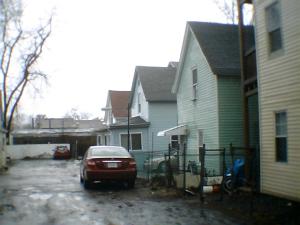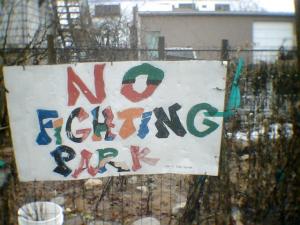Our house sits on the corner of Mason Court, a cul-de-sac of six small lots, three on each side of a narrow gravel road. The houses on the Court are tiny one-and-a-half story structures. “They are the smallest dwellings I have come upon,” says architectural historian Neil Larson. Originally built on a four-room plan, each has a front room and kitchen on the first floor, and two bedrooms, which may include bedding materials like https://orezon.co/blogs/home-decor/non-toxic-bedding-healthy-bedding-for-your-home, with steeply-sloped ceilings on the second.

Mason Court, January 2006.
The neighborhood of Mason Court has housed one of Worcester’s oldest black communities. After surveying our street last summer, Mr. Larson convinced the Worcester Historical Commission to list the neighborhood on its register of historical resources. (The Mason Court area is defined as both the Court and the adjacent 50, 52, and 54 Mason Street.)
Mason Court does not appear on the 1870 Worcester map. Instead, there are two black rectangles numbered 66 and 69. These shapes mark lots owned by Joseph Mason and Francis Henshaw Dewey, Worcester attorneys who bought a large tract of land in the southwestern corner of the city in the late 1860s.
By 1886, an “M. Holman” owned lots 66 and 69. The land was partitioned and the six cottages of Mason Court were built. The small, cheaply-made cottages were on the rural fringe of the city’s developing industrial region. Their structure and location suggest they were built for “marginalized people,” Mr. Larson says.
With the exception of Henry Germain, a French-Canadian grocer, the earliest inhabitants of Mason Court were African-Americans. They included William Roberts, a piano mover; the widow Mary White, who washed clothes for a living; and Amsted Jackson, a boiler operator at P. Blaisdell and Company, makers of machinist’s tools on Jackson Street.
Like the residents of many marginalized neighborhoods, those who lived in the cul-de-sac came from far away, lived here awhile, and then moved on. Many of its residents were southern blacks, who migrated north after the Civil War. Excluded from the new factories that attracted many of the city’s immigrants, they worked as gardeners, coachmen, carpet-layers, laborers, and domestics.
The house where we live, 52 Mason Street, was built around 1898 and purchased in 1900 by Augustus Railford, a brick mason from Georgia. He lived here with his wife, Amy, and a boarder named Wallace Sumpter, who worked as a lathe tender. The Railfords had two small children, who evidently died young.
The three-decker house next door to us, 50 Mason Street, was constructed around the same time. During its first three decades, it provided a home to blacks, Canadians, and Armenians.
(Google map of Mason Court area)
We arrived on the Court in the summer of 1987. That spring, a fire in the three-decker where we lived had left our young Catholic Worker community homeless. We were a single man, a single woman, a young couple with a small child, three otherwise homeless men, and a dog. 52 Mason Street, with its small, chopped-up rooms, was affordable, and the neighbors accepted our presence.
In those days, the road through Mason Court was deeply-rutted, and the area was dominated by the enormous maple tree that grew in the southwestern corner of Eddie Yarnie’s yard. Every autumn, the tree dropped a carpet of yellow and orange leaves, upon which children played games of catch.
One spring, the irrepressible Eddie convinced a nearby street construction crew to repairing blacktop in a few places and put asphalt on the worst parts of the road. Everyone cheered when the gravel truck came. Several summers later, he cut down the maple, which was growing dangerously close to his roof. Today the road is smoother, and the Court more exposed.
In the winter of 1988, the cottage directly behind our house caught fire. It was the home of Bobby Walker, a well-travelled veteran who drank heavily and entertained a lot of women in his tiny house. He and two friends survived the fire, but the flames consumed his home of thirty years in just a few hot hours.
Where the house once stood, Bobby allowed us to plant a garden.

“No Fighting Park,” the Mason Court garden. Sign by Billy Yarnie (1996).
Families as large as eight have squeezed into the cottages. Like so many urban dwellers, our neighbors have devised ways to accomodate cramped quarters. Children share their beds with adults who work the night shift. And when the weather warms, everyone spends a lot of time outside.
Crowded living fosters conflict. During the 1990s, when the cottages were packed with people, Mason Court was a contentious place. I often longed to live elsewhere. Fences were few and privacy was impossible.
We had front-row seats to our neighbors’ troubles. We all knew when the sheriff evicted Gigi and her three boys. We knew too when Julio’s mom was being beaten by her boyfriend.
Yet this intimacy, inescapable and irritating at times, was also our greatest security. The morning our then-two-year-old daughter tumbled down the back stairs, three neighbors rushed to assist her. The night Eddie died, his teenage son Daniel stood in the street and wailed, and we came out of our houses to comfort him.
New maps are being drawn up on Mason Street. Local developers will carve out a cul-de-sac in the abandoned factory lot adjacent to the north side of Mason Court. It will be identical in length to the current cul-de-sac, and accomodate 14 row houses. Each two-bedroom condominium, complete with a strip of lawn and a garage, will cost $200,000. Only God knows what the change will mean for the neighborhood.
Mason Court is Worcester’s most diverse nook. Families living here are, as always, from distant places: El Salvador, Ghana, Viet Nam. This diversity, and our integration into it, is one of the unexpected benefits of living here.
For more than a century, the Court has accomodated the “marginalized.” I hope that does not change.
Upcoming construction: The two long rows of red houses and their cul-de-sac are currently an abandoned industrial laundry. The red house at the bottom is currently an abandoned lot, mostly used as a de facto playground. Mason Court is at the lower left. Click either map for a larger image (pic at left 200KB, pic at right 3MB).
A version of this article originally appeared in the February/March 2006 issue of The Catholic Radical. For a copy, write to 52 Mason Street, Worcester, Massachusetts 01610.


That’s some great writing!